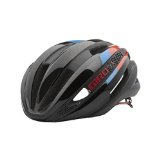In setting out to design the all-new Synthe Helmet, Giro’s stated aim was to eliminate the false choice between aerodynamics and ventilation. It apparently worked. According to the world-class Marianne Vos, the Synthe is “perfect for every race. You don’t have to choose between the two anymore, you can just wear this one.” Giro also chimes in, claiming that the final product is the “fastest aerodynamic profile of any road helmet we’ve ever made.” That’s saying something, coming from the same company that brought us the revolutionary Air Attack helmet. OK, that was a lot of talk but not much evidence of walk. But rest assured that Giro did walk. It walked all the way to the wind tunnel, where it used a metric called Wind Average Drag not to verify that what they had already made was aerodynamically sound, but to actually design the Synthe from the chin strap up. Wind Average Drag produces a single drag value from 72 possible wind angles. By not giving any plain or vent a free pass, Giro has produced a helmet that it claims reduces drag more than most of the non-ventilated, pure-aero road helmets that have flooded the market. Despite this impressive wind tunnel performance, Giro still proudly asserts that the Synthe excels most in the comfort category. The Synthe’s defining element is the incorporation of Aero Mesh Panels, an idea that we typically associate with summer-weight bib shorts. By contributing positively to both, the Aero Mesh Panels are the bridge between aerodynamics and ventilation. In a stroke of functional genius, the panels also include vents that double as ports for glasses. The Roc Loc Air fit adjuster is operable with one hand, to (literally) dial-in pressure and fore/aft tilt for the perfect ride — even while you’re in the middle of it. Air Fit also means that the Roc Loc frame suspends the helmet just enough to facilitate more airflow across your head, which is further boosted by the internal airflow channels and surprisingly-generous-for-a…


